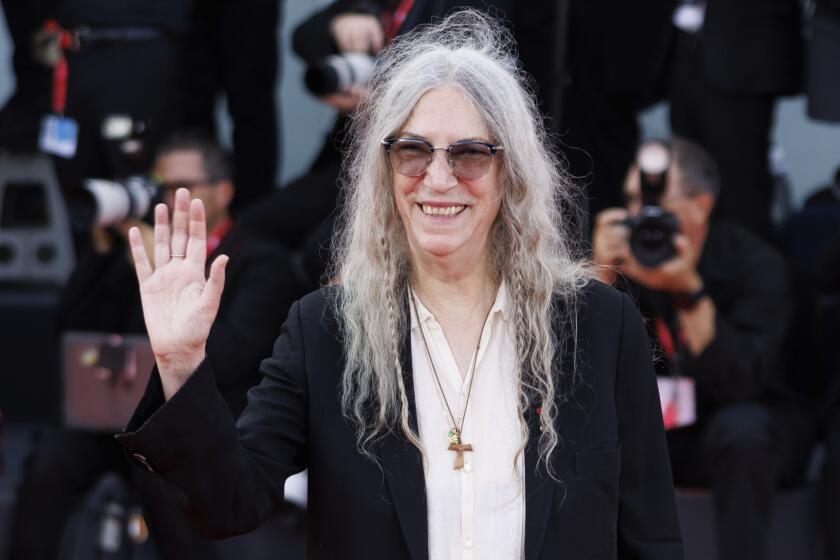Deep re-listening: Fiona Apple’s ‘Extraordinary Machine’
- Share via
During this indeterminate period of staying safer at home, we’re heeding our own advice and whiling away the hours/days/weeks/months by re-listening — very deeply — to some of our favorite records.
And because we’re L.A. Times music writers, we decided we would revisit, and re-assess, classic albums either recorded in, or ostensibly about, California, for a series called “Deep re-listening.”
First up, from 2005: Fiona Apple’s “Extraordinary Machine.”
Fiona Apple sat between Magic Johnson and Jimmy Kimmel, an emissary from Planet Alt flanked by two grinning guys wearing boxy suits.
It was June 2006, and the 29-year-old singer had gone to Kimmel’s late-night TV show to promote her latest album, “Extraordinary Machine,” which she’d been touring behind since its release the previous fall. Kimmel had teed up their chat by mentioning Apple’s “ferociously loyal fanbase” and the album’s best-of-2005 plaudits; he’d kindly plugged her upcoming gig at the Hard Rock Hotel in Las Vegas.
Now Apple was playing ball by dispensing charming stories about her old piano teacher and about Kimmel’s other guest that evening, the Lakers legend, whom Apple said she idolized as a kid growing up between New York and Los Angeles. It was an easy display that would’ve been hard to imagine a decade before, when the singer — named best new artist thanks to her brutally confessional 1996 debut, “Tidal” — famously burned down an MTV awards show with an expletive-laden speech about how “this world is bullsh—.”
Expertly packaged in director Mark Romanek’s porn-adjacent “Criminal” video, Apple entered America’s mind as a kind of defenseless problem child — the “sullen girl,” as she put it in an early song about being raped, “in the blue of my oblivion.” The MTV tirade only deepened the impression that she was beyond repair; ditto her sophomore record, 1999’s “When the Pawn...,” on which she described herself as “a mess he don’t wanna clean up.”
Yet as she sat on Kimmel’s stage, Apple’s congenial banter felt like part of her effort to shake the image of hopeless fragility that had quickly come to define her and her music.

Her pet peeve, she told NPR when “Extraordinary Machine” came out, “is and always has been people close to me worrying about me a little bit too much when they think that maybe I need a little bit more help than I actually do.” It inspired her to write the album’s sly and bouncy title track, which she goes on to perform in that Kimmel clip, the studio audience whooping as she jabs the air with her finger to accentuate the song’s carefully phrased retort:
I seem to you to seek a new disaster every day
You deem me due to clean my view and be at peace and lay
I mean to prove I mean to move in my own way and say
I’ve been getting along for long before you came into the play
Of course, declining the world’s unwelcome concern only invites its condescension, at least for a woman. After pointing out that Apple plays the piano “very hard,” Kimmel asked her to shake his hand so he could gauge the strength of her grip. “Wow, you do have strong hands,” he decided, before adding, “for a girl.” To watch the singer endure such a tired quip — not to mention the crowd’s Pavlovian laughter — is to appreciate the scale of the task before her.
“Extraordinary Machine” captures Apple in a transitional moment — between an extended adolescence and the delayed arrival of adulthood, between the establishment of a caricature and her liberation from it, between the florid singer-songwriter material that made her a star and the more angular, percussive music to come. The third of her five studio albums (including a long-awaited new one, “Fetch the Bolt Cutters,” reportedly due soon), it represents a crucial hinge in Apple’s career, which she seemed to understand even as it was happening. Here’s a record on which the word “agenda” — not an especially lyrical term — crops up twice.

In 2005 the music business around the singer was changing too, moving from a physical-product model to one based on downloads and streams. And that shift was triggering a re-divvying of the creative power shared, often jealously, by artists, producers and executives.
Indeed, although it’s almost laughable now, in an age when record companies compete to sign the latest homegrown viral sensation, “Extraordinary Machine” was regarded for years as an object lesson concerning a label’s interference in an artist’s process. As the story goes, Apple recorded an album’s worth of songs with the producer Jon Brion — a linchpin of the proudly arty scene at L.A.’s Largo club who’d also overseen “When then Pawn…” — during loose, experimental sessions conducted in an improvised studio at the Paramour estate in the Silver Lake hills. Then the suits at Sony Music rejected the result as insufficiently commercial.
Ferociously loyal fans mounted a grassroots “Free Fiona” campaign, shipping foam apples to the label’s headquarters and later assembling on a New York City street to demand the album’s release; eventually it leaked onto the internet, where it met with acclaim from critics. (You can still hear it easily on YouTube.) But that didn’t stop Apple from recording the songs again with a second producer, Mike Elizondo, whose more streamlined version of the album came out with Sony’s approval in October 2005.
Apple has suggested that she remade “Extraordinary Machine” because she wasn’t satisfied with Brion’s production, with its busy arrangements full of old-fashioned instruments. Yet our eagerness to cling to the other narrative — that the singer had been mercilessly stifled by an unfeeling corporation — is its own demonstration of the album’s ideas about women’s agency.
In retrospect the two editions of “Extraordinary Machine” aren’t quite as distinct as we might remember; Elizondo’s claim that his production was “radically different” from Brion’s, as he told the New York Times that year, definitely feels like an overstatement.

Yes, Elizondo — best known at the time for his work with a very different L.A. musical figure, Dr. Dre — drew out the low-slung hip-hop beats in songs like “Tymps (The Sick in the Head Song)” and “Get Him Back,” for which the producer recruited the Roots’ Questlove to play drums. But beneath Brion’s orchestral flourishes, the original album had a crisp boom-bap quality that made clear Apple was already thinking intently about the role of rhythm in her music.
And yes, Brion — beloved by movie-music nerds at the time thanks to his whimsical scores for Paul Thomas Anderson’s “Magnolia” and “Punch-Drunk Love” — deployed strings and wind instruments in a manner that was likely familiar to Apple’s parents, who met as cast members in the Broadway musical “Applause.” But even as he decluttered the album’s sound, Elizondo preserved much of that show-tune romance.
Is “romance” the right word for a tune as righteously indignant as “Get Him Back,” which like many of “Extraordinary Machine’s” dozen tracks is widely thought to chronicle the demise of Apple’s rocky relationship with Anderson? “One man, he disappoint me / He give me the gouge and he take my glee,” she begins the song, “Now every other man I see / Remind me of the one man who disappointed me.”
In “Oh Well” she vividly recounts being cheated on, while “Window” finds her smashing “a filthy pane” out of frustration: “Better that I break the window,” she growls, “than him or her or me.” Again and again, Apple describes the lasting damage of a bad breakup, as in “A Better Version of Me,” where she sings, “I don’t want a home — I’d ruin that.”
Yet it’s not only those lush Hollywood strings that signal Apple’s enduring belief, despite it all, in the possibility of connecting meaningfully with someone. In “Tymps” she’s asking herself why she kissed a guy she knows she should avoid: “I’m either so sick in the head I need to be bled dry to quit / Or I just really used to love him / I sure hope that’s it.” Then there’s “Parting Gift,” about not regretting having taken up with a man who “looked as sincere as a dog” — a true term of endearment from an artist who once called off a tour to be with her dying pit bull — even though it ended poorly.
Singing in a low voice both sultry and muscular, Apple puts across a centered character on “Extraordinary Machine” that contrasts with the more desperate, wounded vocals on her first two albums; she’s somebody, as she spells out in the opening title track, who’s developed a hard-won belief in her ability to weather a storm.
Apple returns explicitly to that theme in the record’s closer, “Waltz (Better Than Fine),” one of two cuts on the official album, along with the opener, drawn from the Brion sessions. Amid a carnivalesque arrangement embellished with piping woodwinds, Apple assures us we have no reason to worry about her — that she’ll be doing OK even if it takes her forever to make her next album (which it did).
“No, I don’t believe in the wasting of time,” she sings, “But I don’t believe that I’m wasting mine.”
The years since have tested that position. “Extraordinary Machine’s” follow-up, “The Idler Wheel...,” came out in 2012; an even longer gap will separate that album and “Fetch the Bolt Cutters,” provided the latter arrives in 2020, as a recent profile in the New Yorker implies it will. In that story we learn that Apple rarely leaves her house near Venice Beach these days; writer Emily Nussbaum describes the singer’s anxiety regarding public scrutiny as such that you wonder whether Apple has been putting off finishing the record because she knows which doors its release will open.
Listening to “Extraordinary Machine,” you hear the singer flinging open those doors, for at least a moment, without fear of what might come through them.
More to Read
The biggest entertainment stories
Get our big stories about Hollywood, film, television, music, arts, culture and more right in your inbox as soon as they publish.
You may occasionally receive promotional content from the Los Angeles Times.











